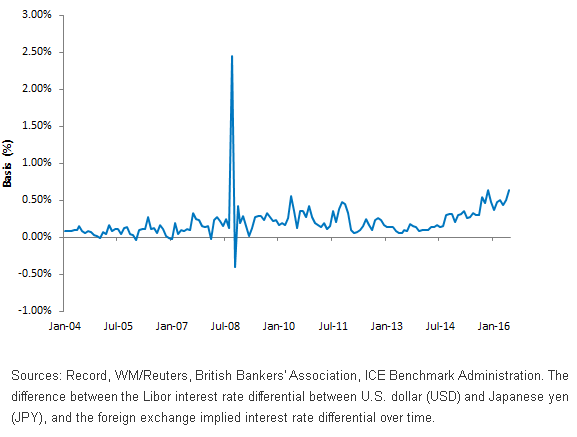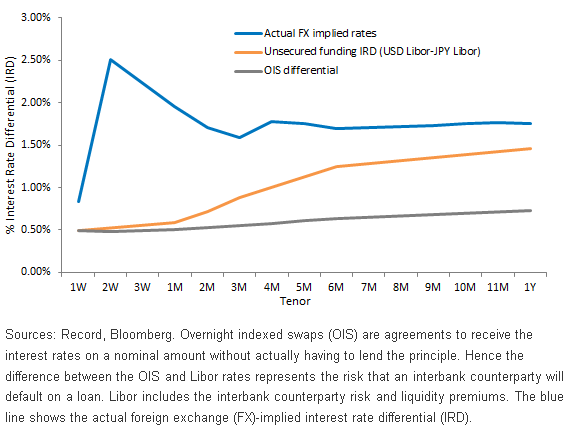Dislocations in the FX Markets and What They Mean for You

 Three Changes Causing Expanded Carry
Among other things, the cause of this lies in three main changes.
First, new banking regulations (primarily the leverage ratio provisions in Basel III1) have restricted the ability of banks to employ their balance sheet in low-margin activities such as rates arbitrage.
Second, LIBOR no longer accurately reflects the price at which unsecured borrowing and lending occurs. Not only have there been fraudulent manipulations of the LIBOR rates, but also the unsecured interbank funding market has been declining in prominence compared to other unsecured markets, particularly those between banks and their customer money pools and between banks and sovereigns. Thus, even to the extent that LIBOR is a true indication of the interbank rate, it no longer accurately captures the costs of unsecured borrowing for a bank.
Third (and more recent), prime money market fund reform in the U.S., the next pillar of which will be implemented by October 17, has increased the share of secured funding compared to unsecured, which allows fewer opportunities for arbitrage.
These three factors have combined to introduce a basis—the difference between the theoretical cost of the borrowing/lending, which corresponds to an FX forward position and the actual cost of these forwards. This basis varies as these factors (and others) interact, but overall can be said to correspond to the currencies’ relative demand as funding currency.
Generally speaking, demand for dollar funding has been high, creating a positive basis for long dollar positions in the currency markets. Thus a U.S. dollar-based investor has achieved a better interest rate from foreign investments hedged back to dollars than would be implied by a simple transfer of risk-free or unsecured rates, which already favor long dollar positions against other major currencies (euro, Japanese yen, British pound, Swiss franc). This is shown for the yen below.
This higher carry earned from hedging the yen is perhaps extra motivation and consideration for U.S. investors to adopt a currency hedged Japanese equity strategy.
USD-JPY Interest Rate Differential Decomposition
Annualized interest rate as of September 15, 2016
Three Changes Causing Expanded Carry
Among other things, the cause of this lies in three main changes.
First, new banking regulations (primarily the leverage ratio provisions in Basel III1) have restricted the ability of banks to employ their balance sheet in low-margin activities such as rates arbitrage.
Second, LIBOR no longer accurately reflects the price at which unsecured borrowing and lending occurs. Not only have there been fraudulent manipulations of the LIBOR rates, but also the unsecured interbank funding market has been declining in prominence compared to other unsecured markets, particularly those between banks and their customer money pools and between banks and sovereigns. Thus, even to the extent that LIBOR is a true indication of the interbank rate, it no longer accurately captures the costs of unsecured borrowing for a bank.
Third (and more recent), prime money market fund reform in the U.S., the next pillar of which will be implemented by October 17, has increased the share of secured funding compared to unsecured, which allows fewer opportunities for arbitrage.
These three factors have combined to introduce a basis—the difference between the theoretical cost of the borrowing/lending, which corresponds to an FX forward position and the actual cost of these forwards. This basis varies as these factors (and others) interact, but overall can be said to correspond to the currencies’ relative demand as funding currency.
Generally speaking, demand for dollar funding has been high, creating a positive basis for long dollar positions in the currency markets. Thus a U.S. dollar-based investor has achieved a better interest rate from foreign investments hedged back to dollars than would be implied by a simple transfer of risk-free or unsecured rates, which already favor long dollar positions against other major currencies (euro, Japanese yen, British pound, Swiss franc). This is shown for the yen below.
This higher carry earned from hedging the yen is perhaps extra motivation and consideration for U.S. investors to adopt a currency hedged Japanese equity strategy.
USD-JPY Interest Rate Differential Decomposition
Annualized interest rate as of September 15, 2016
 1Basel III includes the liquidity covered ratio, the net stable funding ratio, and the leverage ratio framework.
1Basel III includes the liquidity covered ratio, the net stable funding ratio, and the leverage ratio framework.
Important Risks Related to this Article
This article was reprinted with the permission of Record Currency Management. WisdomTree is not responsible for its content and has reprinted this article to be viewed as informational. The information provided to you herein represents the opinions of Record Currency Management and is not intended to be considered a recommendation to participate in any particular trading strategy or deemed to be an offer or sale of any investment product, and it should not be relied on as such. Past performance is not representative of future results.
Neither Record Currency Management nor WisdomTree nor any other party involved in making or compiling any information makes an express or implied warranty or representation with respect to information in this article.
No WisdomTree Fund is sponsored, endorsed, sold or promoted by Record Currency Management (“Record”). Record has licensed certain rights to WisdomTree Investments, Inc., as the index provider to the applicable WisdomTree Funds, and Record is providing no investment advice to any WisdomTree Fund or its advisors. Record makes no representation or warranty, expressed or implied, to the owners of any WisdomTree Fund regarding any associated risks or the advisability of investing in any WisdomTree Fund.


